OBSERVING VARIABLE STARS
Last updated: 6 March 2001
OBSERVING VARIABLE STARS |
Watching Evolution in the Sky:
YOUR GUIDE TO OBSERVING VARIABLE STARS
Introduction
We look out at the vast nighttime sky on a pristine, clear and dark night and sense a nature of "permanence." The constellations - stars construed in patterns hundreds, thousands of light years away - appearing to eyes and our emotions as the "firmament" of a never-changing creation. Such stability appears to be important to the comfort of the human psyche, but indeed....does NOT exist.
Of all things....the wonderful and seemingly static stars are NOT stable. In fact, they are ever-changing: all stars, every one that you can see including even our sun itself.
In many stars, this change can be quite dramatic and certainly visible in modest telescopes or to the naked eye. We have CATACLYSMIC changes such as the "novae" and "supernovae" in which a single event (we'll call it an "explosion" to keep from getting too deep into astrophysical jargon) transforms nearly the entire mass of a huge sun into a bubble of energy and light that spews outward at the speed of light from where a star used to be. Such novae occurred recently in July, 2000 with a sudden flare-up of Delta Scorpii from naked eye magnitude 2.3 to 1.9, and again in February 2001 with a telescopic nova in the constellation of Sagittarius which brightened from fainter than visibility in even the world's largest telescopes to a "star" nearly visible in binoculars, at magnitude 7.7!
The energy released from such catastrophic events is astronomical, literally. When any star changes and YOU are there to witness it - whether it be through the supernovae explosion, or the slow and methodical pulsating of a red giant as it gradually ages - YOU are watching first-hand the actual evolution of something that, in our lifetimes, appears to never change.
But these dramatic and sudden star events are NOT common and there are not too many to choose from. On the other hand, there ARE some wonderful stellar events that YOU can monitor over time periods of just a couple of days, to a year or even several years for the complete event to take place.
Such events are the VARIABLE STARS, stars which change noticeably in brightness. We have seen how the bright star ALGOL, in Perseus, changes its brightness every 2.3 days ( ), a result of a second and darker star eclipsing the first. And among those seemingly never-changing millions of other stars out there visible in your telescopes, the great majority of them also demonstrate such changes.
Such stars include: ECLIPSING BINARY STARS - like Algol, stars which change brightness as one star moves in front or behind the other; REGULAR LONG-PERIOD AND SHORT PERIOD variable stars, many of which are "red giant" stars that actually pulsate in size; the CEPHEID VARIABLES, also pulsating stars but "supergiant yellow" stars; and the CATACLYSMIC VARIABLE STARS, stars which - like the novae and supernovae but not to such an extreme -suddenly brighten without any warning nor predictability. The cataclysmic stars are monitored around-the-clock by astronomers as they cycle from very dim to brighter over a very erratic period of time.
----------------------------------
GETTING STARTED IN VARIABLE STAR OBSERVING
You pretty much already have what you need to start a serious (but still "fun".....as opposed to at "work serious") adventure into observing variable stars, something that still remains primarily in the hands of amateur astronomers armed with everything from binoculars to modest telescopes.
You have: 1) a telescope (probably); 2) yourself and a (hopefully) good set of eyes; 3) a yearning to do something besides just "look" through your ETX or LX telescope; 4) an accurate watch and 5) a computer, or you wouldn't be reading this right now. What you don't have - the CHARTS to find and compare these objects to stars of KNOWN and steady brightness - you ARE about to have access to.
So let's get started paving the way for YOU to do some "serious" scientific research, contribute to astronomy, and have an exciting time cataloging the life of some star that is 1,350 LIGHT YEARS away! What you are about to embark upon is a lesson taught easily to you by one star: R URSA MAJORIS, an easy-to-find long-period variable star in the constellation of Ursa Major, just north of the "big dipper." Figure 1 shows this position of R UMa and how easy it is to find.
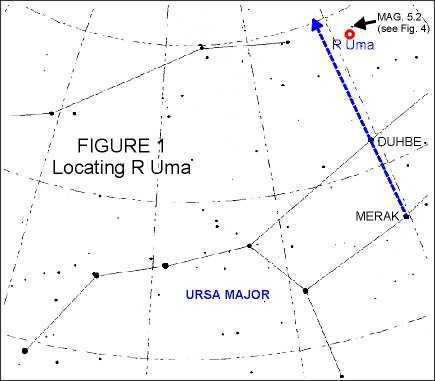
For setting circle use, or to program into your AutoStar, the coordinates (epoch 2000)of this variable star are:
Right Ascension: 10h 44m 34s
Declination: +68 degrees 46m.5
The star varies in magnitude from a faint 13.9 visual (about the limiting magnitude under VERY DARK SKIES with the LX 90) to a very bright 6.6, easily visible in both the DS scopes and the ETX 90. The entire "period" of R UMa is some 302 days with minor fluctuations along the way (that's why it is "fun" to keep up with!). The "period" of any variable star is the length of time it takes to cycle, i.e., from minimum brightness, to maximum and BACK to minimum again to start all over.
R Ursa Majoris is easy to find, even without the GO TO or setting circles. Note in Figure 1, and again in Figure 3 the star marked "52" (the decimal point - 5.2 - is omitted to keep it from being confused with a very faint star!). This star is easy to find by using Duhbe and Merak as a guide (Figure 1); the "52" star is easy to locate with a small finderscope, but not distinct with the naked eye. NOTE that this magitude 5.2 star will remain visible in the SAME field of view as the variable star, even with moderately high magnification (see Figures 3 & 4) and thus assist in your proper identification of the variable.
This is one of the REDDEST long period variables, and the red color can be clearly noted when at brightest. Likely a much older star than our sun, R UMa is about 250x brighter than our sun.
Note in Figure 2, the light curve (you can construct your own by simply plotting the observed magnitude - ON A LONG-PERIOD VARIABLE, OBSERVE ABOUT ONCE PER WEEK through the entire cycle - against the elapsed time) demonstrates that this star brightens TWICE as fast as it dims, taking only about 116 days to rise from minimum brightness to magnitude 6.6!
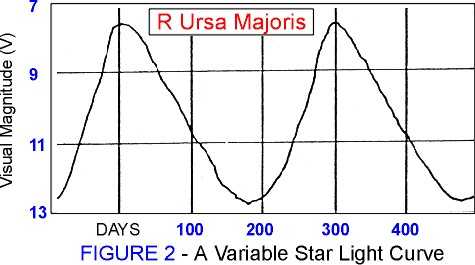
To observe R Ursa Majoris - or any of the thousands of variable stars out there - a wonderful organization, the American Association of Variable Star Observers (A.A.V.S.O.) has compiled excellent and FREE star finder charts for you to: 1) locate your target star; and 2) find stars of KNOWN brightness with which to compare and evaluate YOUR estimate of the variable's brightness every time you observe it. Samples of these charts are given here, and more is said about obtaining these charts and the AAVSO throughout this observing Guide.
----------------------------------
FINDING YOUR VARIABLE STAR
To find your target star is easy; once you have located it correctly each time thereafter the star can be spotted even quicker. For those not using a GO TO or setting circles to find the star (as might be the case with R UMa since it is so easily found as noted above), the AAVSO has several DIFFERENT charts available for nearly EACH variable, and each is indexed alphabetically. The "a" charts are FINDER CHARTS, showing a very wide field of sky as you would see it with the naked eye or with your finderscope; NOTE that the variable star will nearly ALWAYS be in the middle of the finder chart (unless more than one variable is denoted on that chart). From there, once you can locate the brighter stars around it, you can "zero-in" on your target by moving up to AAVSO chart "b" (shown in Figures 3 and 4) which is a narrower field and shows even fainter comparison stars (REMEMBER: the decimal point is left out of the magnitude numbers!). For most observing - except when the star reaches a VERY FAINT magnitude - you will be using Charts "c". When very faint, you might need to move up to Chart "d" (Figure 8), which normally shows a telescopic field (about 1/2 to 1 degree across...they always have a scale at the BOTTOM) and a "limiting magnitude" of comparison stars of about 13th or 14th.
The field and limiting magnitude of Chart "d" is ideal for your medium-to-high power magnitude estimates in your telescope, necessary when R UMa is reaching its dimmest point of the cycle.
Note carefully two stars that are marked with red ARROWS in BOTH Figures 4 and 8 (NOTE: both of these charts are "reversed charts", specially made for telescopes like yours, either Cassegrain or Maksutov to allow the field of view to be matched with that provided by ETX and LX telescopes; these reversed charts are discussed in detail following). I have drawn in these arrows to allow you to have a "reference point" between two very different charts, both of which you will be using with your telescope. Figure 4 shows the two stars - magnitude "105" and "110" clearly marked; this chart is the 'b" chart which has a total field of view of about 3 degrees. Figure 8 shows the SAME two stars in relation to the variable star, but it has a much more narrow field of view - only 1 degree total - so that you can increase your magnification to see the fainter stars.
These and all other variable star charts may be downloaded from the AAVSO web site for FREE by logging onto: charts.aavso.org.
So, simply "find" the star's position (even if you can't SEE it) using the "a" chart and your finderscope (since you are using your naked eye or perhaps a straight-through finder to locate the star in a constellation and wide field, you do NOT use a "reversed chart" for an "a" chart); then tweak in your finderscope crosshairs even closer with the "b" (reversed) chart until you have found the field of view that MATCHES the stars seen on the chart (see "Using Reversed Charts", following). At this point, if the star is near maximum brightness, you may be able to use the wide field and brighter comparison stars of the "b" chart to make your estimate; if not, then proceed up to the "c" chart and make the estimate.
The procedure for accurately estimating a star's brightness visually is very simple and is given following.
That's all there is to it. Using an accurate watch (to within a minute - log onto nist.time.gov for your time accurate to 0.7 second) merely write down the date and time (in Universal time) and the magnitude that you determine for the star.
You observation is VERY IMPORTANT. The AAVSO and professional astronomers world-wide are relying on amateur astronomers to make these observations! If you cannot observe regularly, that is fine; but every time you DO observe a variable, be sure to report it! The correct reporting format so that your observation can be included (you can even get an INSTANT light curve on each star that will update to include YOUR observation!) by logging on to: aavso.org/adata/curvegenerator.shtml
----------------------------------
VARIABLE STAR CHARTS - Using Reversed Star Charts
Until recently, all available star charts including those for variable stars, were printed "astronomically-correct," whereas SOUTH is at the TOP, EAST is to the RIGHT and WEST is at the LEFT of the chart. This orientation matches: 1) Newtonian reflectors; 2) refractors with no right-angle prism; 3) most astronomical photographs taken at prime focus of a telescope. Such an AAVSO chart is the "standard" chart and is shown for R UMa in Figure 3.
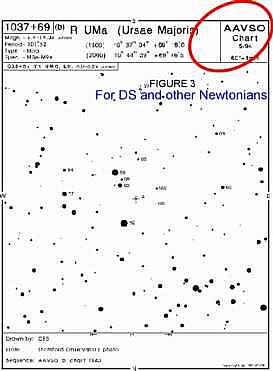
This was bad news for the popular Cassegrain and Catadioptic telescopes, the very design of all popular GO TO and portable telescopes on today's market! With the ETX an LX telescopes, a mirror or prism is used to divert the optical path at a right angle for viewing comfort and convenience; this provides a MIRROR IMAGE (or an "odd number of reflections" of the light path). Hence, attempting to use the older charts for serious variable star indentification was nearly impossible with a catadioptic scope.
Today, the AAVSO - realizing the growing number of these telescopes and the importance of the great many observers who would like to contribute estimates on a regular basis - provides "REVERSED" charts to give the exact orientation as one might see through the eyepiece of an ETX or LX telescope. Compare Figure 3 with Figure 4: BOTH are "b" charts for R UMA, same scale and same field of view. Figure 4 is the newer "reversed" chart for the ETX / LX orientation. It will match the sky as you see it in your eyepiece....Figure 3 will NOT. So, when you download from the AAVSO Chart Index, ALWAYS go to the charts that are marked with an "R" at the end of the chart designation for the proper ETX / LX chart.
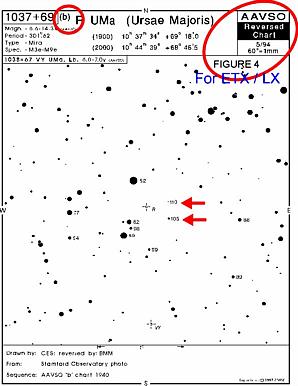
A closeup from BOTH the regular and "reversed" charts of the immediate area surrounding R UMa is shown in Figure 5 so that you may get an idea of just how different the two charts are. Using the older chart with the ETX or LX would be difficult, if not impossible to most people. In the new charts, the orientation is as follows to match the ETX / LX telescope:
NORTH - "TOP"
SOUTH - "BOTTOM'
EAST - "RIGHT"
WEST - "LEFT"
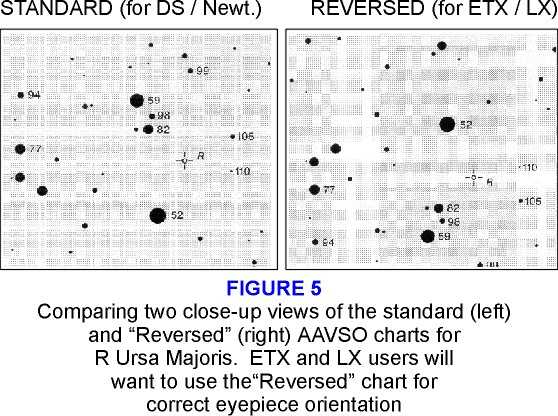
----------------------------------
MAKING YOUR BRIGHTNESS ESTIMATE
Estimating the brightness of a variable star is simple and fun. It requires that you carefully locate a suitable "comparison star" for which the AAVSO has assigned a magnitude, and make sure that the star you are estimating is, indeed, the RIGHT star - it is easy to become confused! After several observations requiring you to locate the star, you will become familiar with both the field of stars surrounding it, and the proper identification of the star itself....like so many things, the first time is always the most frustrating and difficult!
Variable star observing should be "fun" as well as rewarding. Over a period of time, you will see the fruits of your labor as you compile your own light curves like the one in Figure 2. The following steps will get you started in variable star observing. A complete guide is available from the AAVSO at charts.aavso.org that will take you even further once you have mastered this high-in-the-sky and easy to monitor variable star, R Ursa Majoris:
1) It is important to not worry with stars you cannot see; that is why I have selected R Ursa Majoris for TWO reasons: a) it can be monitored both when bright and at its faintest light with our ETX and LX scopes in just a little less than one year; and, b) it is in a "circumpolar constellation" meaning that - from ind-northern and higher latitudes, Ursa Major is up all night long, 365 nights a year! If you decide to observe variable other than R UMa, DO NOY select a star with a magnitude range mostly out of your limiting magnitude range when it is at faintest; do not bother - concentrate on stars you KNOW that at least most of the time you can see;
2) only use the star magnitudes given on the AAVSO star charts; these have been carefully checked and okayed for precision in visual work; do not use the GSC or other sources for estimates;
3) always use two stars and extrapolated between the magnitudes, unless you find a comparison star that is EXACTLY a match in brightness to the variable. Position both the variable and the comparison star so that they are both located at the same distance from the edges of your field of view (Figure 6);
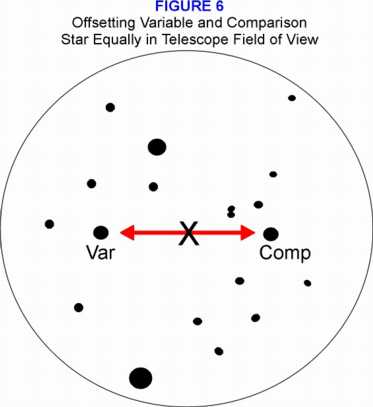
4) a lot of variable stars, by nature, are RED, just as is R UMa; there is an optical effect known as the "Perkinje Effect" that allows reddish objects to appear brighter and brighter to the human eye theylonger they are "looked at." Therefore, do not STARE at the variable, but rather keep your eye moving between comparison star and the variable at all times;
5) only use stars for comparison that are CLOSE IN MAGNITUDE to the variable....do not guess; if you cannot find a suitable star, then you should use a wider-field chart (i.e., if you are using a "c" chart and there is not a suitable comparison star handy, then you should try the "b", wider-field chart). Figure 7 shows correct comparison stars that I would select if R UMa was, say, magnitude 9.6. (the reason I DID NOT pick the magnitude "98" (decimal omitted!) star near the center and nearer to the variable is that it is too close to the magnitude "82" star and thereby difficult to get a clear brightness reading in my opinion);
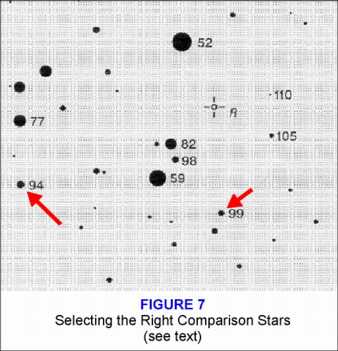
6) use the "OUT OF FOCUS" comparison method if you are having difficulty deciding; do not get frustrated if you can't quite make up your mind; DEFOCUS your telescope slightly and make a "disk" rather than a point out of your star image; diffusing the light helps you to discern very slight differences in brightness!
7) if you cannot see the star on a given night - even though you have been tracking it for some time - then the star has dropped BELOW YOUR LIMITING MAGNITUDE. If your limiting magnitude (see my Limiting Magnitude Test on this website) is, say 11.7 as it might be in the ETX 90, then enter your estimate for the evening as "<11.7, meaning it is FAINTER than 11.7, which is the faintest star you can SEE ON THAT NIGHT. FIGURE 6 shows the center sections of the R UMA "d" chart (much smaller field of view and much fainter comparison stars) so that you can appreciate the detail at which the AAVSO has gone to supply you with accurate star magnitude estimates to very faint stars).
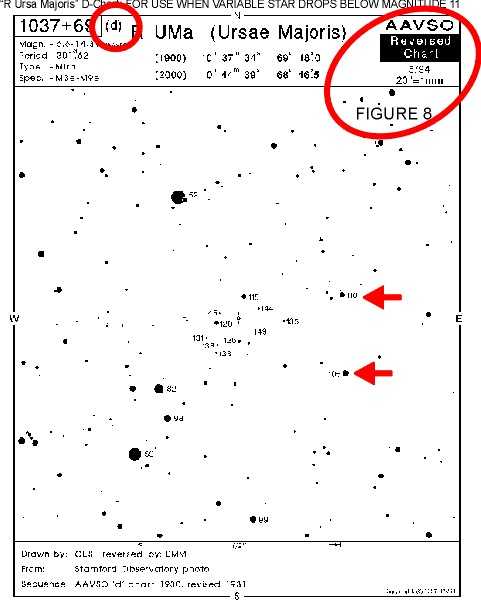
8) NEVER estimate the brightness of the variable when it is on the EDGE of the field of view; eyepieces and telescopes scopes have a "fall-off" from 100% illumination toward the edge of the field; therefore, when possible have both the variable and comparison star (Figure 7) as near to center when making our final estimate as possible.
9) always remember to check your watch or clock at the time you make your estimate; never leave anything to memory; a flashlight and clipboard at your side will encourage you to WRITE down your time and estimate at the time you make it!
--------------------------------
This has been but a "crash course" introduction into variable star observing that I hope will whet your appetite for more. Log onto the AAVSO web site and learn more about this exciting and rewarding offshoot of your already-exciting hobby, and contribute a bit toward the future of science.
Too many times we all find ourselves in that "...well, I've had my look-around now....what's next? is THAT all there is to do?" and merely leave the telescope indoors when you COULD open up an entirely new realm of astronomy. Go ahead: Take the plunge! Find R Ursa Majoris tonight and make that FIRST estimate....you'll never forget the day that you did!
And just think...in only 302 days, you can compile a complete scientific light curve showing the actual evolution of this star in your own lifetime. And you just THOUGHT that things never changed in space!
P. Clay Sherrod
Arkansas Sky Observatory
Conway / Petit Jean Mountain
Arkansas
Return to the top of this page.
Go back to the Observational Guides & References page.
Go back to my ETX Home Page.